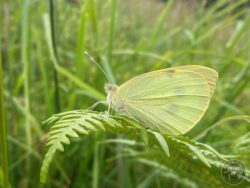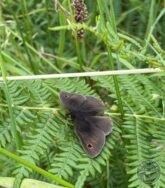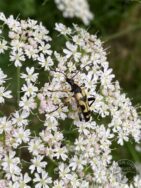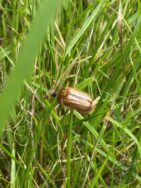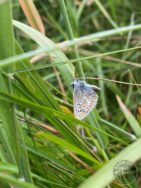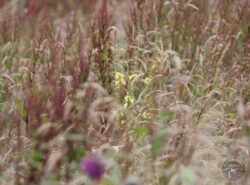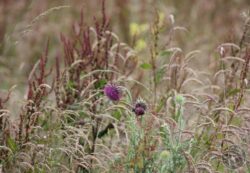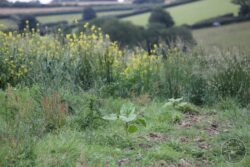A Butterfly Walk on the afternoon of the 2nd revealed more butterflies than during June, but numbers are extremely, and worryingly, low compared to other years. Species spotted included Small and Large Skippers, Marbled Whites, Ringlet, Meadow Browns and one Gatekeeper. We also saw a few Six Spot Burnet Moths and their cocoons on the grass stems, several half-grown Great Green Bush Crickets and a few Grasshoppers. The bright yellow Forage Rape was in full flower in the winter bird food crop and Cornflower and Corn Camomile are beginning to flower in the nectar strip. As we walked down the Long Path we heard a lot of buzzing and saw bees disappearing into the soil at the base of the Forage Rape and Oats.
- Great Green Bush Cricket
- Skipper
- Large White
- Meadow Brown
- Black & Yellow Longhorn Beetle on Cow Parsley
- May Bug
- Common Blue
- Ringlet
Volunteers joined Harry on the 3rd (Steve and Penny) and the 5th (Ian and Jane) for a morning of Bracken Bashing. This weakens the rhizomes and reduces the spread. On a lunch time walk on the 5th a Hobby Falcon was seen hunting over the top of the Main Field. Slow Worms were seen under a corrugated sheet and a Field Vole nest under the other. House Martins joined the Swallows hunting over the top of the Main Field on the 7th, most noticeable because of their calls and feeding their young on the wing. Slender Mullein, Musk Mallow, Musk Thistle, Chicory, Oxeye Daisy, Bird’s-foot Trefoil and White Campion flowers can all be seen dotted among the rough grass in the old winter bird crop area. Unfortunately, in this year’s winter bird food crop, the 12kg of Sunflower Seeds we planted have produced very few plants.
- Slender Mullien
- Musk Thistle
- Poor Sunflower crop this year
On the 8th Harry started strimming around the bird crop as the grass was shorting out the electric fence. He finished it on the 9th after a morning bashing Bracken in North Park with volunteer Ian and they started on the largest patch on the roadside edge. In Corner Wood, one of the three boxes erected for Daubenton’s Bats had fallen down on and was found on the path on the 10th, no sign of use.
More Bracken bashing with volunteer Tim on the 11th, again on the on the roadside edge. There were more butterflies around on the 12th, but still significantly fewer than previous years.
The rain during the first two weeks of the month seems to have responsible for the disappearance of the bees we were seeing going into the soil at the base of the Forage Rape and Oats. As with the butterflies there are far fewer this year. On the 16th we noticed that the Spear Thistles, now in full flower, and which would normally be covered in pollinators when the sun shone, had absolutely no visiting bees or butterflies.
By the 17th, one of the few (7) days of the month with no rain, we had had 103.4mm rain, the average here for July is 72.6mm, so this is more 42% more than our usual monthly total so far. The mean temperature so far this month is 14.2°C, whereas our average is 16.45°C, so we are more than 2°C cooler than usual as well.
The good news is the grassland is teaming with Grasshoppers, and Crickets can be heard chirring amongst the grass and flowering plants. We have Hedge Bedstraw, Common Marsh Bedstraw, Field Bindweed (Convolvulus arvensis), Musk Mallow, Chicory, Bird’s-foot Trefoil and Yarrow (Achillea), amongst others, in full flower now. The winter bird food crop is bright yellow with the Forage Rape and the Oats seem to be doing well too.
On the 17th, Pip, Harry and a student with us on work experience placement, started removing the fence and posts at the bottom of Forde Orchard. On the 19th Harry finished replacing the double height fence that was falling down between Forde Orchard and Waterleat.
A Dipper was recorded flying downstream from the top bridge on the Apprentice Path on the 22nd. There have been a few sightings this summer, leading to hopes they might eventually return to breed one day in one of the boxes under the bridges. On the 24th, six Woodcrete Swallow cups were fitted in the second field shelter (Kiln Close).
On the 29th, a Silver-washed Fritillary butterfly and a Speckled Wood were spotted in Corner Wood. The plucked remains and wing of a Magpie were found on the Long Path in Main Field. The wing was under one of the wooden posts. About a dozen Sunflowers have flowered in the crop, peering above the rest of the plants: not many to show for the 12kg of seed we planted. A few Linnets have appeared and seem to be feeding on the Forage Rape seeds.
The mean temperature here in July was 15.6°C, almost a degree cooler than our 19-year average of 16.4°C although very slightly warmer than the same month last year. We had 14 days of rain totalling 123.6mm, less than July 2023 which recorded 176.2mm but much wetter than our 19-year average of 79.48mm.
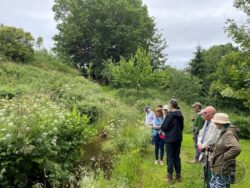
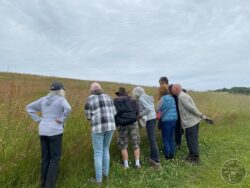
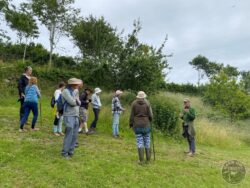
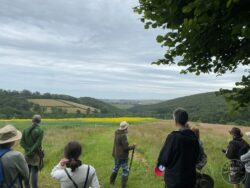
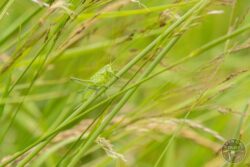
![Llp skipper [harry hingston] 040724 (a)](https://staging.barnowltrust.org.uk/wp-content/uploads/LLP-Skipper-Harry-Hingston-040724-A-1-250x188.jpg)
